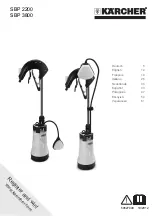
ADJUSTMENTS & OPERATION
TAbLE ADJUSTMENTS
In order for proper jointing operation, the infeed and outfeed tables must be
coplanar. This means that the infeed and outfeed tables are set along the same
plane, forming a perfectly flat surface. If the tables are not coplanar, the workpiece
could be slightly tapered or twisted after jointing. The tables are set coplanar from
the factory, but should be checked with use to ensure they remain set properly.
To determine if the infeed and outfeed tables are coplanar:
NOTE:
Ensure the tables are locked in position when checking.
1. Disconnect the machine from the power source.
2. Loosen the cutterhead guard lock knob (B) Fig.9 and remove the cutterhead
guard by sliding it out.
3. Loosen the two fence assembly lock handles (A) Fig.10 and slide the fence
assembly back as far as it will go to clear the table surface.
4. Place a straight edge (A) Fig.11 across the back of the outfeed table (B),
extending over the infeed table (C) as shown.
5. Rotate the cutterhead so the cutter inserts do not interfere with the straight
edge.
6. If needed, raise the infeed table (C) until it makes contact with the straight edge.
7. If the straight edge sits flat across both tables, they are coplanar. If adjustment
is needed, perform the following adjustments.
The adjustments consist of adjusting either the five set screws (B) Fig.12 at the
back of the machine which adjust the table pitch and tilt at the back, or adjusting
the two cap screws that adjust the table at the front.
1. Disconnect the machine from the power source.
2. Loosen the table lock levers and lift the table into the fully upright position.
Making the rear adjustment:
1. Loosen the three hex. bolts (A) Fig.12 on one side, using a 13mm wrench.
2. Adjust the five set screws (B) in small increments. Rotating the set screws
clockwise will raise the table, and counterclockwise will lower it. The set screws
on the left will have the most impact on the left side of the table, and the set
screws on the right will have the most impact on the right side of the table. The
set screw in the middle should be tightened last, to create even tension on the
base plate.
3. When adjustment is complete, retighten the three hex. bolts (A).
4. Repeat the above steps for the other side of the machine, if necessary.
Making the front adjustment:
1. Using two 13mm wrenches, hold the hex. bolt (A) Fig.13 in place, and loosen hex. nut (B). Repeat for the second hex. bolt and hex. nut.
2. Adjust the hex. bolts (A) in small increments. Rotating the hex. bolts clockwise will raise the table, and counterclockwise will lower it. The
hex. bolts on the left will have the most impact on the left side of the table, and the hex. bolts on the right will have the most impact on the
right side of the table.
3. When adjustment is complete, secure hex. bolts and hex. nuts.
4. Repeat the above steps for the other side of the machine, if necessary.
NOTE:
These adjustments may need to be repeated until the tables are coplanar.
FIGURE 11
FIGURE 12
FIGURE 13































